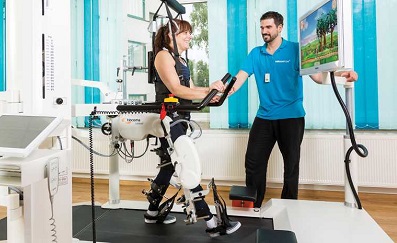“Therapy robots could help patients get back on track more quickly.”
News
Professor Robert Riener writes in ETH Zurich that conventional physical therapy for stroke survivors is not intensive enough. According to Prof. Riener, therapy robots can help increase the number of repetitions – and thus the intensity of therapy.
“Every seventh person reading this blog will suffer a stroke one day. In Switzerland, it affects 16,000 people every year, and worldwide more than six million. And as our population ages, stroke incidence is rising. During a stroke, entire areas of the brain decay, often leading to severe paralysis of one half of the body, speech and vision disorders, and impaired cognitive performance.
Patients with symptoms of paralysis require physiotherapy and occupational therapy over a period of several weeks to months. Progress here depends on the frequent repetition of muscle and joint exercises or complex body movements – similar to motor development in children or in learning a sport.
However, when we compare the intensity of movement in neurorehabilitation with that in motor development in childhood or in sport, the intensity prescribed and practised is far lower. This is one of the main reasons why there are so few success stories in movement therapy after a stroke – patients rarely completely recover from paralysis and their quality of life often remains poor. A higher intensity, i.e. a greater number of repetitions of movements, generally reaps better results. So to be successful, therapies must become more intensive…
Clinical staff, stroke patients, and their relatives all need to be better informed so that they are prepared to increase the intensity of therapy. However, deploying more personnel is cost-intensive, and this is where robots could come in. If used correctly and at full capacity, therapy robots can help increase the number of repetitions and thus the intensity of therapy without generating significantly more costs. Indeed, they’re perhaps the only answer, given the demographically induced increase in stroke patients and the decrease in the number of available therapists.”

